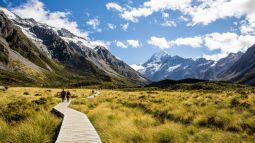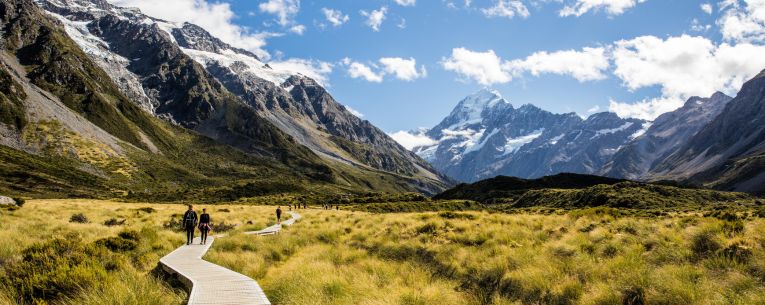As of July 2025, hikers who want to make the trek to the summit of Mount Fuji — Japan’s most revered natural sight — must pay a 4,000-yen ($27) access fee. Japan is joining a growing list of countries this year that are instituting or increasing entry fees to help protect natural areas from over-tourism, fund environmental protection efforts and support local economies.
The post-pandemic surge in adventure tourism worldwide has led many countries to adopt fees as protective measures. By 2024, international tourism returned to pre-pandemic highs, United Nations Tourism reports. The international adventure tourism market, specifically, was valued at 804.5 billion USD in 2024 and is expected to grow to 1,682.28 billion USD by 2032 — an average annual increase of more than 9.4 percent, write industry consultants Fortune Business Insights.
While new access fees in 2025 will require more planning and financial resources for travelers, the initiatives allocate tourism revenue to the protection of natural treasures for future visitors and local nationals. “By raising funds from those directly using the trails, countries can avoid overreliance on general taxes and ensure that tourism contributes directly to local communities,” writes Travel and Tour World.
We have the latest on access fees for some of the most popular natural areas around the world, how host countries are using access fee revenue and what you should know before you go.
Mount Fuji, Japan
Designated a UNESCO World Heritage site in 2013, Mount Fuji is the highest peak in Japan at an impressive 3,776 meters. Trails to its summit see heavy traffic as Fuji is a must-do for visitors of Japan.
New rules:
Starting in July 2025, hikers of the four most used routes to the top of Mount Fuji, must pay a fee of 4,000 yen, roughly 28 USD. Previously, only hikers of Yoshida Trail, the most popular route to Fuji’s summit, were required to pay a fee, and the new rules have doubled the cost to access Yoshida Trail.
Additionally, hikers are required to take a short class on hiking safety and rules, due to a recent increase in medical rescues on the trails. Visitors must also reserve a time slot to climb via an online reservation system that limits the daily number of climbers.
The mountain will also be closed from 2 p.m to 3 a.m daily to visitors who have not rented overnight hiking shelters. Yoshida Trail, the mountain’s most popular trail, is estimated to take six hours to climb and four hours to descend.
Where your money goes:
Officials hope the access fees will reduce foot traffic within Fuji’s fragile natural environment. Other initiatives funded by the fees include maintenance for eroding trails, staff salaries, toilet facilities, safety measures and other infrastructure improvements.
Mount Everest, Nepal
The world’s tallest peak has a big trash problem. For decades, Everest’s fragile landscape has been threatened by the huge amount of litter left behind by climbers — oxygen tanks, food packaging, tents, crampons, human waste and more. Volunteers and the Nepalese government continually remove waste from the mountain, but an incredible amount of work remains.
New rules:
To improve trash removal and other recreation initiatives, Nepal has increased entrance fees for climbing Mount Everest by 36 percent, effective by September 2025. Access permits will cost 15,000 USD for the main climbing season from April to May, up from 11,000 USD.
During the September through November shoulder season, and the infrequently climbed December to February period, fees also increased 36 percent to 7,500 USD and 3,750 USD, respectively.
Where your money goes:
The fee increases are the first for Everest in nearly a decade and will directly fund garbage collection programs. Nepalese officials also want to reduce overcrowding and ensure that only the most prepared climbers tackle Everest. Improvements in search and rescue operations, infrastructure and weather forecasting will also be funded by the fee increases.
Island of Madeira, Portugal
The Island of Eternal Spring, Madeira, is a subtropical paradise for beachcombers and adventurers. The semi-autonomous island is located southwest of mainland Portugal, off the coast of Africa. Unfortunately, erosion and littering are damaging Madeira’s wild areas due to trail over use.
New Rules:
For decades, Madeira officials have required hikers to pay a €3 fee to access the island’s most popular trails: Pico do Arieiro, Pico Ruivo, Levada do Risco, Levada do Caldeirão Verde, Balcões, Levada do Rei and Ponta de São Lourenço. As of January 2025, the €3 hiking fee was extended to more trails for a total of 30 trails. Failure to purchase a pass results in a €50 fine. Children under the age of 12 don’t require a pass.
Where your money goes:
The Institute of Forests and Nature Conservation will use the funds for trail maintenance and nature conservation.
Bwindi Impenetrable National Park, Uganda
A UNESCO World Heritage Site, Bwindi Impenetrable National Park is home to half the world’s population of mountain gorillas who live protected in the park’s diverse rainforest environment. Bwindi is the most accessible place to see mountain Gorillas, UNESCO writes. Guided gorilla tours grant hour-long visits to observe the gorillas habituated to humans — an incredible experience. Keep in mind that the hiking to reach the access points can be rigorous and the tours are relatively expensive.
New Rules:
Effective July 1, The Ugandan Wildlife Authority will increase the cost of standard gorilla trekking permits for Bwindi Impenetrable and Mgahinga Gorilla National Parks from $700 to $800 for foreign tourists, and from $500 to $700 for East African Community citizens and foreign residents.
Where your money goes:
The fee increase will go toward the continued protection and conservation of mountain gorilla troops in Uganda, which are critically endangered. “The revised fee structure will provide essential funds for park operations, law enforcement activities, community projects, and health monitoring of gorilla groups habituated for tourism,” writes the Ugandan Wildlife Authority.
New Zealand
New Zealand is a land of extreme beauty — from the other worldly Waitomo Glow Worm Caves in the far north, to towering Franz Josef Glacier due south. New Zealand’s natural wonders are major tourist draws, that grew even more popular when the country’s landscapes were showcased to the world in the Lord of the Rings movie franchise.
New Rules:
This isn’t a 2025 change, but you may have missed that starting in October last year, New Zealand nearly tripled its International Visitor Conservation and Tourism Levy; a fee charged to international visitors of the country. The fee will go from NZ $35 ($21.50) to NZ $100 ($62.20). Visitors from Australia aren’t required to pay the fee.
Where your money goes:
Enacted in 2019, the IVL funds conservation and tourism initiatives by New Zealand’s government. The IVL increase is meant to help offset the growing costs to taxpayers of New Zealand’s tourism sector, and came as higher costs for tourist visas also kicked in.
International visitors spent an estimated $11 billion in New Zealand in the fiscal year ending in March 2024, “but international tourism also comes with costs to local communities, including additional pressure on regional infrastructure and higher upkeep and maintenance costs across our conservation estate,” said Matt Doocey, minister of tourism and hospitality.
Some helpful tips for navigating new tourism levies
As more parks, cities and nations charge entry fees, “tourism taxes are something we might all have to consider budgeting for in our future travel plans, wherever we choose to visit,” write researchers of tourism from Bangor University. While budgeting for these seemingly inevitable costs, it may be gratifying to remember that you’re doing your part to contribute to nature preservation and bolstering the economy of your host country.
Though there are instances where you may be able to avoid or pay lower fees during the off-season, it often isn’t advisable. For example, climbing Everest during the winter off-season exposes you to dangerously cold temperatures that put you at risk of hypothermia and frost bite.
Not only could hiking extreme destinations during off-season put you at risk, it potentially endangers rescue crews should you need assistance. Many natural attractions, such as the trails on Mount Fuji, also close during the winter, anyway, so make sure you know before you go.
Since the landscape of tourism fees changes constantly, be sure to check official tourism and park websites for the latest. Be sure to leave room in your budget for unexpected fees for specific sights and localities, in case your plans change, and you want to add more to your itinerary.
Keep in mind that many tourism fees were introduced to improve conservation measures and rescue crews remote locations. In addition to paying the fees, you can help meet these goals by practicing leave-no-trace principles and not adventuring outside of your abilities. Hire a guide if necessary and ensure you are physically fit for your trek. Carry a basic first kit and enough water and food for your day of hiking.
Purchasing travel insurance is a necessary precaution when touring these natural areas.
Travel insurance with benefits for emergency medical care and emergency medical transportation can be essential when recreating in remote areas. Accidents can happen on the trail and emergency medical evacuation can easily cost thousands. You should also know that your domestic health insurance policy most likely won’t protect you if you experience a medical emergency abroad. An Allianz Travel Insurance plan with emergency medical transportation and emergency medical care benefits may help in the event of a covered emergency.
We also offer travel insurance plans with trip cancellation and interruption benefits, which can save you thousands if you are planning an international trip to a wild area and need to cancel for a covered reason. Let’s say a storm causes your hike and accommodations to be unsafe and parks officials are advising you to stay home. If you purchased travel insurance before the storm was forecasted, you may be reimbursed for non-refundable trip expenses. You could postpone your vacation for a better time, without losing out on money.
Get a quote to find out how we can protect you during your next trip.
Related Articles








Share this Page